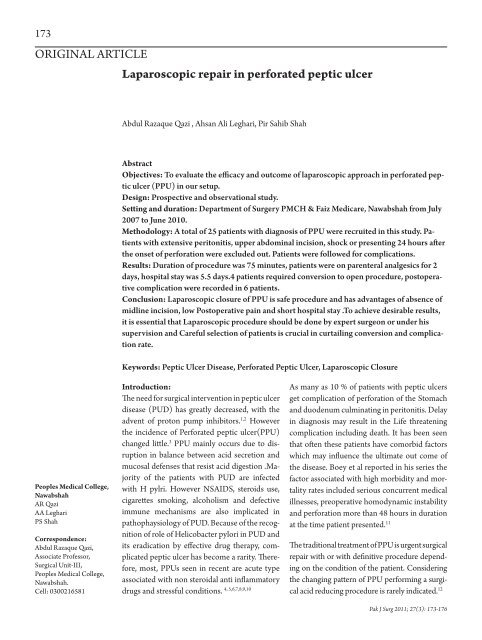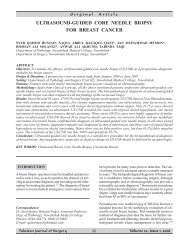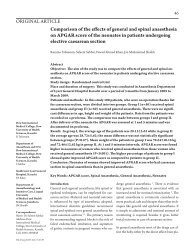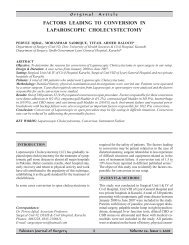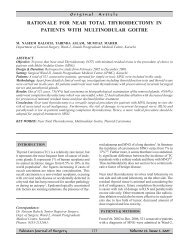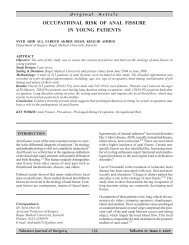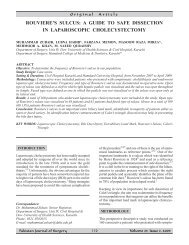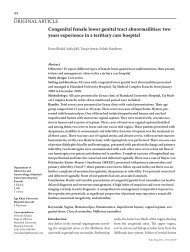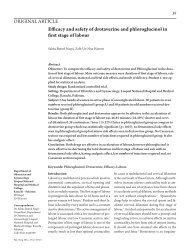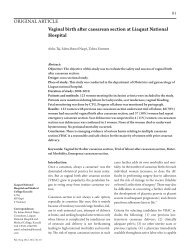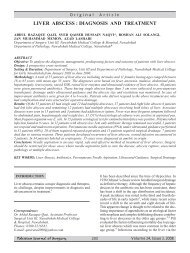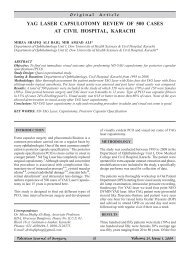Laparoscopic repair in perforated peptic ulcer
Laparoscopic repair in perforated peptic ulcer
Laparoscopic repair in perforated peptic ulcer
Create successful ePaper yourself
Turn your PDF publications into a flip-book with our unique Google optimized e-Paper software.
173ORIGINAL ARTICLE<strong>Laparoscopic</strong> <strong>repair</strong> <strong>in</strong> <strong>perforated</strong> <strong>peptic</strong> <strong>ulcer</strong>Abdul Razaque Qazi , Ahsan Ali Leghari, Pir Sahib ShahAbstractObjectives: To evaluate the efficacy and outcome of laparoscopic approach <strong>in</strong> <strong>perforated</strong> <strong>peptic</strong><strong>ulcer</strong> (PPU) <strong>in</strong> our setup.Design: Prospective and observational study.Sett<strong>in</strong>g and duration: Department of Surgery PMCH & Faiz Medicare, Nawabshah from July2007 to June 2010.Methodology: A total of 25 patients with diagnosis of PPU were recruited <strong>in</strong> this study. Patientswith extensive peritonitis, upper abdom<strong>in</strong>al <strong>in</strong>cision, shock or present<strong>in</strong>g 24 hours afterthe onset of perforation were excluded out. Patients were followed for complications.Results: Duration of procedure was 75 m<strong>in</strong>utes, patients were on parenteral analgesics for 2days, hospital stay was 5.5 days.4 patients required conversion to open procedure, postoperativecomplication were recorded <strong>in</strong> 6 patients.Conclusion: <strong>Laparoscopic</strong> closure of PPU is safe procedure and has advantages of absence ofmidl<strong>in</strong>e <strong>in</strong>cision, low Postoperative pa<strong>in</strong> and short hospital stay .To achieve desirable results,it is essential that <strong>Laparoscopic</strong> procedure should be done by expert surgeon or under hissupervision and Careful selection of patients is crucial <strong>in</strong> curtail<strong>in</strong>g conversion and complicationrate.Keywords: Peptic Ulcer Disease, Perforated Peptic Ulcer, <strong>Laparoscopic</strong> ClosurePeoples Medical College,NawabshahAR QaziAA LeghariPS ShahCorrespondence:Abdul Razaque Qazi,Associate Professor,Surgical Unit-III,Peoples Medical College,Nawabshah.Cell: 0300216581Introduction:AsThe need for surgical <strong>in</strong>tervention <strong>in</strong> <strong>peptic</strong> <strong>ulcer</strong>disease (PUD) has greatly decreased, with theadvent of proton pump <strong>in</strong>hibitors. 1,2 Howeverthe <strong>in</strong>cidence of Perforated <strong>peptic</strong> <strong>ulcer</strong>(PPU)changed little. 3 PPU ma<strong>in</strong>ly occurs due to disruption<strong>in</strong> balance between acid secretion andmucosal defenses that resist acid digestion .Majorityof the patients with PUD are <strong>in</strong>fectedwith H pylri. However NSAIDS, steroids use,cigarettes smok<strong>in</strong>g, alcoholism and defectiveimmune mechanisms are also implicated <strong>in</strong>pathophaysiology of PUD. Because of the recognitionof role of Helicobacter pylori <strong>in</strong> PUD andits eradication by effective drug therapy, complicated<strong>peptic</strong> <strong>ulcer</strong> has become a rarity. Therefore,most, PPUs seen <strong>in</strong> recent are acute typeassociated with non steroidal anti <strong>in</strong>flammatory4, 5,6,7,8,9,10drugs and stressful conditions.many as 10 % of patients with <strong>peptic</strong> <strong>ulcer</strong>sget complication of perforation of the Stomachand duodenum culm<strong>in</strong>at<strong>in</strong>g <strong>in</strong> peritonitis. Delay<strong>in</strong> diagnosis may result <strong>in</strong> the Life threaten<strong>in</strong>gcomplication <strong>in</strong>clud<strong>in</strong>g death. It has been seenthat often these patients have comorbid factorswhich may <strong>in</strong>fluence the ultimate out come ofthe disease. Boey et al reported <strong>in</strong> his series thefactor associated with high morbidity and mortalityrates <strong>in</strong>cluded serious concurrent medicalillnesses, preoperative homodynamic <strong>in</strong>stabilityand perforation more than 48 hours <strong>in</strong> durationat the time patient presented. 11The traditional treatment of PPU is urgent surgical<strong>repair</strong> with or with def<strong>in</strong>itive procedure depend<strong>in</strong>gon the condition of the patient. Consider<strong>in</strong>gthe chang<strong>in</strong>g pattern of PPU perform<strong>in</strong>g a surgicalacid reduc<strong>in</strong>g procedure is rarely <strong>in</strong>dicated. 12Pak J Surg 2011; 27(3): 173-176
<strong>Laparoscopic</strong> <strong>repair</strong> <strong>in</strong> <strong>perforated</strong> <strong>peptic</strong> <strong>ulcer</strong>In open procedure after thorough peritoneallavage, perforation is closed with or with outre<strong>in</strong>forcement of omental patch. Few surgeonsdur<strong>in</strong>g emergency <strong>peptic</strong> <strong>ulcer</strong> surgery haveadequate experience with selective vagotomy,therefore it is recommended that suture oromental flap is followed by medical treatment<strong>in</strong>clud<strong>in</strong>g elim<strong>in</strong>ation of H pylori if present otherwisema<strong>in</strong>ta<strong>in</strong> on proton pump <strong>in</strong>hibitor. 13<strong>Laparoscopic</strong> treatment of PPU was first reportedby Mouret et al <strong>in</strong> 1989 14 followed soon afterby Nathanson et al. 15 The recognized advantagesof laparoscopy are decreased postoperative pa<strong>in</strong>,early mobilization, early return to work andlower complication rate, make this treatmentmodality attractive to many surgeons all over theworld. Nonetheless there are relative contra <strong>in</strong>dicationswhich <strong>in</strong>clude elderly patients, cardiacpathology, chronic respiratory <strong>in</strong>sufficiency,obesity, cirrhosis and sever coagulopthies.There are variety of techniques to close the perforationlaparoscopically such as <strong>in</strong>tra and extracorporeal knots, hold<strong>in</strong>g omental path with fibr<strong>in</strong>glue or seal<strong>in</strong>g with gelat<strong>in</strong> etc. The aim ofthis study was to evaluate the efficacy and safetyof laparoscopic closure of PPU and also identifythose patients who are not suitable for this treatmentmodality.Materials and Methods:Total 25 patients were recruited for this prospectivestudy. This study was conducted from July2007 to June 2010 and all patients were attemptedfor laparoscopic closure of PPU <strong>in</strong> SurgicalUnit 3, PMCH and private hospital. The diagnosiswas based on sudden onset of severe, sharpabdom<strong>in</strong>al pa<strong>in</strong> present <strong>in</strong> epigastrium or generalizedpa<strong>in</strong> accompanied by nausea and vomit<strong>in</strong>g.On exam<strong>in</strong>ation obvious distress, tachycardia,tachypnoea along with abdom<strong>in</strong>al signs oftenderness guard<strong>in</strong>g and rigidity. Patients werealso asked about past history of PUD, <strong>in</strong>take ofNSAIDS, alcohol and smok<strong>in</strong>g. Rout<strong>in</strong>e <strong>in</strong>vestigationssuch as Blood CP, serum amylase, bloodurea, chest x-ray <strong>in</strong> erect posture and US werealso performed to reach the diagnosis. Exclusioncriteria for this procedure were extensiveperitonitis, upper abdom<strong>in</strong>al <strong>in</strong>cision, patients174presented 24 hours after perforation and shock.Parameters observed were operative time, <strong>in</strong>traoperative and post operative complication, pa<strong>in</strong>management, hospital stay and rate of conversionto open surgery. Once the diagnosis of PPUwas established patient resuscitated aggressivelybefore the operation. Laparoscopy performedvia 4 ports one port <strong>in</strong> the umbilicus for camera,2 work<strong>in</strong>g ports at right and left upper abdomenand one port <strong>in</strong> the epigastrium to retract thequadrate lobe of the liver. 2-0 vicryl used for closureof perforation and omental patch anchoredover the perforation with vicryl stitche to sealthe perforation completely, thorough abdom<strong>in</strong>allavage performed with sal<strong>in</strong>e.Results:In 25 consecutive patient’s laparoscopic closureof <strong>perforated</strong> <strong>peptic</strong> <strong>ulcer</strong> (PPU) attempted.There were 20 (80%) patients males and 5(20%)females (Figure-1). The mean age was 42.2(22-75) years (Figure-2). The mean operativetime was 75 (55 to 110) m<strong>in</strong>utes. Patients havestarted oral <strong>in</strong>take from third day. The mean postoperative hospital stay was 5-8 days. In 5(16%)24%20%20%16%24%80%Figure 1: Sex Distribution (n= 25)16%Figure 2: Age Distribution (n= 25)FemaleMale65-7555-6545-5535-4525-35Pak J Surg 2011; 27(3): 173-176
175 AR Qazi , AA Leghari, PS Shahpatients conversion to open procedure was necessitateddue to follow<strong>in</strong>g reasons, i.e large sizeof <strong>ulcer</strong>, suspected malignancy <strong>in</strong> gastric <strong>ulcer</strong>and presence of local abscess (Table-1). Thepostoperative complications were chest <strong>in</strong>fectionrecurrence of perforation, <strong>in</strong>fection of umbilicalport and subphrenic abscess (Table-2).Discussion:Advances <strong>in</strong> medical treatment of PUD havedramatically reduced the number of electiveProcedure performed for this disease. Nonethelessthe rate of complications appears to beunchanged. PPU is a notorious complicationof PUD frequently leads to peritonitis. Initialtreatment to be directed toward correction ofhypovolaemia and any electrolyte imbalance.Oliguria and poor peripheral perfusion are contra<strong>in</strong>dicationto immediate operative treatmentand their correction should take precedenceeven over radiological studies. 16 There is nodoubt that some patients with <strong>perforated</strong> <strong>ulcer</strong>can be managed non operatively with successfulout come. The problem with this approach,which is reserved for poor risk elderly patients,is a high <strong>in</strong>cidence of a residual abscess formation,particularly <strong>in</strong> subphrenic region whichwill subsequently require dra<strong>in</strong>age. 17 The issuethat has been raised often is whether the patientwith <strong>perforated</strong> <strong>peptic</strong> <strong>ulcer</strong> must be operatedon by an open procedure or laparoscopic techniqueshould be employed. Simple closure withomental patch is not a demand<strong>in</strong>g procedure fora surgeon who is able to perform <strong>in</strong>tracorporealknots. The choice between comb<strong>in</strong><strong>in</strong>g def<strong>in</strong>itivetreatment and simple closure of the perforationis still a matter of controversy. This choice dependupon certa<strong>in</strong> factors, <strong>in</strong>clud<strong>in</strong>g the age andfitness of the patient and the status of peritonealcavity. 18 Laparoscopy has significant advantagethat it allows more accurate visualization of peritonealcavity and can evacuate collection of fluidTable 1: Reasons for Conversion (n=25)Number ofReasonsPatients(%)Large size of Perforation (>1cm) 02(33%)Local Abscess 02(33%)Gastric Cancer 01(16%)which may be distant from perforation. Otherestablish advantages are less postoperative pa<strong>in</strong>which is supported by significant reduction <strong>in</strong>post operative analgesic requirement, avoidanceof excessive gut manipulation reflects <strong>in</strong>short period of ileus, early oral <strong>in</strong>take of food.Early mobilization , short hospital stay an earlyresumption of work make this technique an attractivealternative to laparotomy. However thisapproach is not as popular as laparoscopic cholecystectomydue to disadvantages of significantlyprolong duration of operation and high rate ofsuture leak requir<strong>in</strong>g repeated operation. Dur<strong>in</strong>gthe 2 years study period we only manage to select25 patients due to strict criteria <strong>in</strong> which weexcluded patients with any risk factors, patientspresented 24 hours after perforation and due tolack of facility of laparoscopy <strong>in</strong> emergency onlyfew patients underwent procedure at electivelist, however majority of patients were operatedat private hospital. In our study duration ofoperation was average 75 (65 to 110) m<strong>in</strong>utes,which is consistent with studies conducted bySchirus e al 19 and different from Mastuda 20 . Oneof disadvantages of this technique is significantlylonger time than open procedure, howeverwith <strong>in</strong>creas<strong>in</strong>g expertise the operative time oflaparoscopy become shorter. In our series parenteralanalgesics were given for first 2 days. Averagehospital stay was 6.5 (5 to 8) days, whichwas also observed by Arnaude al 21 . 4( 5.7 %) patientsnecessitated conversion to open ,the mostcommon reasons were large size(more than 1cm), gastric cancer and presence of abscess. Thepostoperative complications were chest <strong>in</strong>fections,subphrenic abscess and re-operation dueto suture leak. Abscess was dra<strong>in</strong>ed under ultrasoundand leak required repeated procedure. Siuet al 22 found that laparoscopic <strong>repair</strong> PPU wasa safe and reliable procedure, associated with ashorter operat<strong>in</strong>g time, less postoperative pa<strong>in</strong>,Table 2: Post Operative Complication (n=25)Number ofComplicationPatients(%)Recurrent Perforation 02(08%)Chest Infection 02(08%)Port Infection 01(04%)Subphrenic Abscess 01(04%)Pak J Surg 2011; 27(3): 173-176
<strong>Laparoscopic</strong> <strong>repair</strong> <strong>in</strong> <strong>perforated</strong> <strong>peptic</strong> <strong>ulcer</strong>reduced chest complications, a shorter postoperativehospital stay and return to normal dailyactivities than the normal conventional surgery.Conclusion:Our study has shown that laparoscopic PPU closureis not a difficult technique can supplant theopen procedure due to its advantages of fewerrequirements of analgesics, short hospital stayand early return to work with cosmetically acceptablescar.References:1. High TB.Perforated <strong>peptic</strong> ulces.In: Schwart,s Ellis H (eds)Ma<strong>in</strong>gut abdom<strong>in</strong>al operations.(1990),vol.1.9th Ed.Appletonand Lange East Norwalt,CT.2. So JB, Kum CK, Fernandes ML, Goh P.comparision betweenlaparoscpic and Conventional omental patch <strong>repair</strong> for <strong>perforated</strong>duodenal <strong>ulcer</strong>.Surg Endosc 1997; 11(10): 1017-1020.3. Norman S.Williams, Christopher J.K. Bulstrode, P. RonanO,Connell.Perforated <strong>peptic</strong> Ulcer.Baily &Love,s short practiceof surgery.Edition 25 th,vol.2.2008.1062-1064.4. Gunshefski L, Flancbaum L, Brol<strong>in</strong> RE, Frankel A;Chang<strong>in</strong>gpattern <strong>in</strong> <strong>perforated</strong> <strong>peptic</strong> <strong>ulcer</strong> disease.Am Surg.1990; 56(4):270-4.5. Gil<strong>in</strong>sky nh:Peptic <strong>ulcer</strong> disease <strong>in</strong> elderly.Gastroenterol Cl<strong>in</strong>North Am. 1990:19(2) 255-71.6. Cock JR: Perforated <strong>peptic</strong> <strong>ulcer</strong>- the chang<strong>in</strong>g scene. DigDis.1992; 10 (1): 10-6.7. Dzienisewski, Jarosz M: Guidel<strong>in</strong>e <strong>in</strong> the medical treament ofHelicobacter pylori <strong>in</strong>fection. J Physiol Pharmacol.2006; 57:143-54.8. Candelli M, Nista EC, Carloni E, et al: Treatment of H. pylori<strong>in</strong>fection: a review. Curr Med Chem. 2005; 12 (4): 375-84.9. Malferte<strong>in</strong>ner P, Megraud F, O,Mora<strong>in</strong> C, et al: Current con-176cepts <strong>in</strong> the management of Helicobacter pylori <strong>in</strong>fection: theMaasstricht 3 Consensus Report.Gut.2007; 56(6): 772-81.10. Gisbert JP, Legido J, Garcia-Sanz I, Pajares JM: Helicobacterpylori and <strong>perforated</strong> <strong>peptic</strong> <strong>ulcer</strong> prevalence of the <strong>in</strong>fectionand role of non-steroidal anti-<strong>in</strong>flammatory drugs. Dig LiverDis.2004; 36 (2): 116-20.11. Boey J, Wong J, Ong GB.Prospective study of operative riskfactors <strong>in</strong> <strong>perforated</strong> duodenal <strong>ulcer</strong>s.Ann Surg1982; 195:265.12. Plummer JM, McFarlane ME, Newnham:Surgical managementof <strong>perforated</strong> duodenal <strong>ulcer</strong>: the chang<strong>in</strong>g scene. WestIndian Med J. 2004; 53(6); 378-81.13. Johnson AG. Proximal gastric vagotomy: does it have a place<strong>in</strong> the future management of <strong>peptic</strong> <strong>ulcer</strong>? World J Surg2000;24:259.14. Mouret P, Fracois Y, Vagnol J, et al. <strong>Laparoscopic</strong> treatment of<strong>perforated</strong> <strong>peptic</strong> <strong>ulcer</strong>. Br J Surg 1990; 77: 1006.15. Nathanson LK, Easter DW, Cuschieri A, <strong>Laparoscopic</strong> <strong>repair</strong>/peritoneal toilet of <strong>perforated</strong> duodenal <strong>ulcer</strong>. Surg Endosc.1990;4(4):232-3.16. Cusceiri A, Steel RJC, Moosa AR.. Acute gastoduodenal disorder,Essential surgical practice,4 th ed.vol.1 2002; 273-274.17. Cuscheiri A, Steel RJC, Moosa AR.Acute gastoduedenal disorders,Essential surgical practice, 4th ed. Vol 1 2002; 273-274.18. C. Palanivelu. Laparoscpic management of <strong>perforated</strong> duodenal<strong>ulcer</strong>, Art of laparoscopic surgery, 1st ed. Vol 1 2007;450-456.19. Schirru A, Cavaliere D, Caristo I, etal. {Operative laparoscopy<strong>in</strong> the managementof <strong>perforated</strong> <strong>peptic</strong> <strong>ulcer</strong>}.{Article <strong>in</strong> Italian). Chir Ital. 2004 Mac-Apr;56(2):247-52.20. Matsuda M, Nishiyama M, Hanai T,etal.<strong>Laparoscopic</strong>omental patch <strong>repair</strong> of <strong>perforated</strong> <strong>peptic</strong> <strong>ulcer</strong>.Ann Surg1995;221(3):236-240.21. Arnaud JP, Tuech JJ, Bergamaschi R, etal. <strong>Laparoscopic</strong> sutureclosure of <strong>perforated</strong> duodenal <strong>peptic</strong> <strong>ulcer</strong>. Surg LaparoscEndosc Tech. 2002 Jun; 12(3): 145-7.22. Siu WT, Leong HT, Law BK, etal.<strong>Laparoscopic</strong> <strong>repair</strong> of <strong>perforated</strong><strong>peptic</strong> <strong>ulcer</strong>: a randomized controlled trial.Ann Surg.2002 Mar;235(3):313-9.Pak J Surg 2011; 27(3): 173-176


